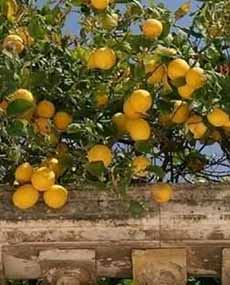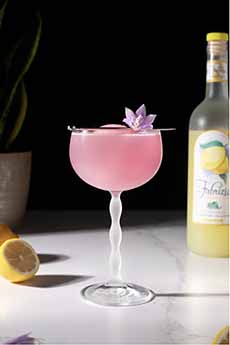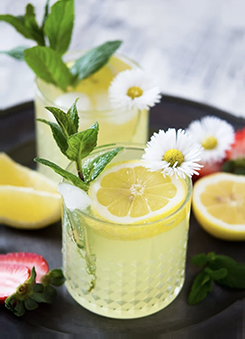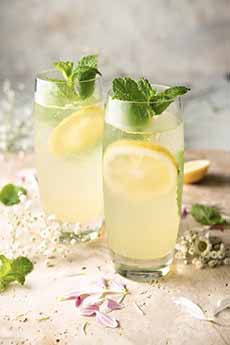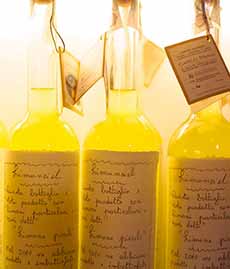Fabrizia Limoncello: A Gold Standard American Lemon Liqueur
|
|
Welcome to American limoncello! You may know limoncello as an Italian liqueur, and it is. But a family in New England has been making their own and racking up awards so they’ve expanded to other liqueurs, canned cocktails, and baked goods. While we’ve had a number of imported brands of limoncello, the artisanal, all-natural limoncello from Fabrizia Spirits, has taken our fancy. If you’re not familiar with limoncello: Limoncello is lemon liqueur. It has been enjoyed in Italy for close to a century (see the history below, as an apéritif before a meal, a digestif after dinner and as a palate cleanser between courses. (Keep the bottle in the freezer to enjoy a chilled shot, sipping slowly.) Limoncello is made from lemon peel/rind/zest (which contains lots of great-tasting lemon oil) and juice, with vodka (or grappa) as the base spirit, plus sugar and water. The latter two ingredients are turned into simple syrup. The lemons infuse in the vodka for a few weeks, giving the vodka an intense lemon flavor. The simple syrup is then added. Brands have different levels of sweetness based on the taste of the producer (some like it sweet, others less so—we’re with the Team Less So). The liqueur is sweet, not tart. And yes, you can make it at home. Here’s a recipe. To viewers of the Hotel Portofino television series on Brit Box and PBS, the alcohol-averse Lady Latchmere may or may not have been served “Italian lemonade,” limoncello added to conventional lemonade. Perhaps she was given straight limoncello: The woman needed to chill! Limoncello has its own food holiday: June 22nd is National Limoncello Day. And plan to make Italian lemonade on August 20th, National Lemonade Day. In New England, the Mastroianni family made limoncello at home with a recipe from relatives who live in the hilltop village of Platania, overlooking the Mediterranean Sea in the Calabria region of Italy. Fabrizia, meaning “one who works with his hands,” gives the nod to artisan craftsmanship. What started in a tiny garage in Massachusetts many years ago became award-winning Fabrizia Limoncello made with Sicilian lemons. Among other awards, it won the gold medal in the prestigious San Francisco World Spirits Competition. Now produced in Salem, New Hampshire, it’s the leading Limoncello in America. The family traveled to Sicily in order to find the perfect lemons for their products. Why Sicilian lemons? Sicily has been called the “Lemon Riviera,” claiming the world’s finest lemons. The island has been cultivating lemons for more than 1,200 years. The Bay of Palermo was once called the Conca d’Oro, Shell of Gold, because of the many groves of bright yellow citrus fruits gleaming in the sunshine. The Mediterranean climate and rich volcanic soil surrounding Mt. Edna give Sicilian lemons a special sweetness and flavor. They are less acidic than other varieties and the variety has a thick oily skin, delivering lemon oil that is perfect for making good limoncello. According to one article, nine out of ten lemons sold in Italy come from Sicily [source]. Here are the different varieties (subspecies) of Sicilian lemons. Variations of limoncello include arancello (flavored with oranges), agrumello (flavored with mixed citrus), pistachiocello (flavored with pistachio nuts), meloncello (flavored with cantaloupe), and fragoncello (flavored with strawberry). A version made cream is called crema di limoncello. Fabrizia has developed a line of liqueurs and ready-to-drink products and also created the Fabrizia Lemon Baking Company. Fortunately, there are still artisan producers of the traditional Italian spirit, like Fabrizia Spirits. Fabrizia limoncello tastes fresh and natural, and bright with the flavor of citrus oil. Trivia: Why is limoncello cloudy? Limoncello is cloudy/opaque due to the high content of the oil in the lemon peel. The oil molecules dissolve in the clear high-proof vodka. But the subsequent addition of sugar lowers the ethanol percentage of the vodka. This brings the lemon oil out of the solution, where it mixes/emulsifies with water molecules in the simple syrup. (This is the same process by which absinthe turns cloudy when water is added.) Also, I wanted to share about our Lemon Baking Company. When the pandemic hit, and restaurants and bars shut down, the family sought another way to keep their staff working. In 2020 they launched the Lemon Baking Company, incorporating their lLimoncello into blondies, biscotti, cookies, cake jars, lemon loaves, and whoopie pies. Ready to dig in? > For beverages, head to FabriziasSpirits.com. > For baked goods, head to FabriziaLemonBakingCompany.com. While limoncello was made to sip straight, it is a great mixer. There are many limoncello cocktail recipes, and you can create your own. The classic Lemon Drop Cocktail combines vodka with lemon juice, triple sec, and simple syrup. But make your own version with vodka and limoncello. Or combine gin or tequila with limoncello. Or with tonic water or mineral water. Check out this Pink Limoncello Reviver cocktail from Moody Mixologist (photo #3). Here are two more recipes: Cranberry Lemonade With Limoncello, and an update of the Screwdriver made with orange vodka, fresh orange juice, and limoncello. And here are yet more limoncello cocktails. |
|
|
Beyond cocktails, try limoncello over ice cream, sorbet, or fruit salad, and drizzle it over pound cake. In fact, you can punch holes in the top of a pound cake or angel food cake with a cake tester, and brush limoncello over the top. It will seep in (feel free to brush it more than once). Delicious! THE HISTORY OF LIMONCELLO It may sound cliched for such a recently-commercialized product, but the history of limoncello is shrouded in mystery. There is no historical documentation of limoncello before the beginning of the 20th century. Outside of a handful of families and social circles, few Italians drank it before 1988, when the entrepreneur Massimo Canale of Capri registered the trademark “Limoncello di Capri” and began producing it in quantities that could first be sold commercially to bars, restaurants, and supermarkets throughout the area. There are numerous printed mentions of limoncello, but no indication of where, or when, limoncello was invented. The fact is that most liqueurs were made either by monks or by families with access to the ingredients. So anyone with a lemon tree could have been making the liqueur for generations. Massimo Canale’s great-aunt, Maria Antonia Farace, made limoncello from the early 1900s onward, at her boardinghouse in Azzurra. She turned the lemons in her garden into the liqueur. During the postwar period, her nephew opened a bar that specialized in the lemon liquor made with Farace’s old recipe. In 1988, his son, Farace’s great-nephew Massimo Canale, started a small handmade production of limoncello, and registered the trademark* Limoncello. So is that the end of it? No! Sorrento and Amalfi have their own origin stories regarding the production of the lemon liqueur, which go back much further. Here are other origin stories from the city of Sorrento and the the Amalfi coast [source]. These origin stories take the production back to the Middle Ages. And that, ladies and gents, is the reason behind the actual origin of limoncello. No doubt, lemon-based liqueurs are much older than 1900, and maybe even older than the Middle Ages. Where there was plentiful fruit, it was turned into liqueur by monks or families. Lemons are believed to have originated in northwestern India, where they have been cultivated for more than 2,500 years. Arab traders brought the lemons to the Middle East and Africa sometime after 100 C.E. Lemons arrived in Sicily, during the 9th century Arab invasions. Many families made their own liqueurs at home, some of which, like amaretto, became major brands. Whatever the origin, limoncello became popular throughout Italy, and from there to Europe and the U.S. And the name? The English translation of the limoncello means “of a yellow colo.” In some Italian dialects it also refers to a small kind of lemon with a smooth peel [source]. > The different types of lemons. *In 1992, Charles C. Winchester filed for the American trademark, but it was abandoned in 2000, likely because the term had become generic [source]. CHECK OUT WHAT’S HAPPENING ON OUR HOME PAGE, THENIBBLE.COM.
|
||

